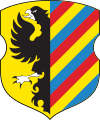Nieśwież
|
Nesvizh Нясвіж (Belarusian) Несвиж (Russian) Nieśwież |
|||
|---|---|---|---|
 |
|||
|
|||
 Location of Nesvizh, shown within the Minsk Region |
|||
| Coordinates: 53°13′N 26°40′E / 53.217°N 26.667°E | |||
| Country Region District |
Nesvizh District |
||
| First mentioned | 1223 | ||
| Population (2009) | |||
| • Total | 14,300 | ||
| Time zone | FET (UTC+3) | ||
| Area code(s) | +375 1770 | ||
| Website | [1] | ||
Nesvizh (Belarusian: Нясві́ж [nʲaˈsʲvʲiʐ], Niasviž; Russian: Не́свиж; Polish: Nieśwież; Yiddish: ניעסוויז; Latin: Nesvisium; Lithuanian: Nesvyžius) is a city in Belarus. It is the administrative center of the Nesvizh District (rajon) of Minsk Province and location of the Nesvizh Castle World Heritage Site. Its 2009 population is 14,300.
Nesvizh was first documented in 1223, later becoming a part of the Grand Duchy of Lithuania. In the 15th century, while still a minor town, it passed to the Radziwiłł princely family, and remained the family's home until 1813. The first Belarusian language book printed in the Latin alphabet, a catechism by Symon Budny, was published in Nesvizh in 1562.Nesvizh Castle was founded in 1583, and between 1584 and 1598 two monasteries and a collegium, all belonging to different religious orders, were built. On the initiative of Mikołaj "the Orphan" Radziwiłł the city was granted Magdeburg rights in 1586. Two epidemics that occurred in the city in the 17th century led to an establishment of a pharmacy in 1627.
...
Wikipedia


